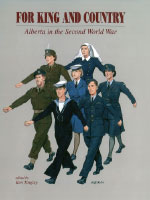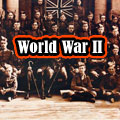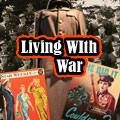Alberta's Indians and the Second World War
James Dempsey
Reprinted with permission of the author and publisher of For King and Country: Alberta in the Second World War When Canada declared war on the Axis countries in September 1939, the response from the native population proved to be as enthusiastic as that shown by most other Canadians who feared the Fascist menace. Over the next five years, Alberta's natives supported the war effort by enlisting for active service in the armed forces and contributing significantly to the home front effort. The latter was achieved by finding employment in the war factories, supplying finances for war funds, and working to increase agricultural production on the reserves.
When Canada declared war on the Axis countries in September 1939, the response from the native population proved to be as enthusiastic as that shown by most other Canadians who feared the Fascist menace. Over the next five years, Alberta's natives supported the war effort by enlisting for active service in the armed forces and contributing significantly to the home front effort. The latter was achieved by finding employment in the war factories, supplying finances for war funds, and working to increase agricultural production on the reserves.
Natives' sense of loyalty to the King of England was a strong inducement to participate in the war effort, as it had been in the First World War. But unlike the previous war, Indians ultimately became eligible for conscription, in spite of treaty stipulations to the contrary. These treaties, made between the Indians and the Crown in the 19th century, promised that Indians would not be required to participate in any of Canada's foreign wars, but they were overruled when conscription was introduced in 1944. The controversy over the conscription issue and other government policies will be examined with native Albertans' contributions during the Second World War.
Indian participation in active service between 1939 and 1945 was remarkable. They were represented in every rank from Private to Brigadier, and fought in every theatre of the war. Their total recorded number of enlistments reached 3090, of which 213 died in service and 93 were wounded.1
Indians saw action in theatres as diverse as Hong Kong, where seven men saw action against the Japanese, and the famous raids on Norway and Dieppe. At Dieppe, two natives died and three were captured.2
Natives served in all three services, though their presence was mainly felt in the Army. Only nine Indians served in the Royal Canadian Navy, 82 enlisted in the Veterans Guard of Canada, and 29 were members of the Royal Canadian Air Force.3 Educational requirements for the RCAF barred many Indian enlistees, which was a blow to the many who tried to join.4 Their rejection from the Air Force, because their education was not on a par with that of non-Indians, showed that improvements were needed in the native education system if it was to provide an education equal to that of non-Indians. Undaunted, 46 Canadian Indians crossed the border and joined the United States Air Force.5
Indian women also joined the three armed services, with a total of 72 enlisting.6 Some were involved in overseas duties, while civilian women worked on the home front, organizing campaign committees and clubs to aid in the war effort.7
Ontario, with the largest population among the provinces, provided the largest enlistment of natives with 1324 men and women joining up. Saskatchewan was second with 443 men, and Alberta contributed 144 enlistees.8 The percentage of Indian participation across Canada was considered to be equal to the 35 per cent rate for eligible males which had been attained in the First World War. This fact was commented upon by the Hon. John Diefenbaker during debate preceding the conscription plebiscite, when he stated that "by percentage Canada's Indians had the highest enlistment rate of any race and if others were like them there would be no need for a plebiscite."9 An important point to be remembered when referring to native enlistment figures for both world wars is the fact that they do not include many Indians from the far north who enlisted, enfranchised natives, nor those who missed the national registration. Bearing this in mind, estimates for Second World War enlistment could have reached the 4000 level attained during the First World War.
The Indians of Canada were in a unique situation as wards of the Federal government in that they did not have the rights or responsibilities of citizenship.10 This exemption can be traced back to the signing of the treaties in western Canada during the 1870s. The Hon. Alexander Morris, who negotiated some of the treaties for the Crown, was specifically asked by the Indians during Treaty Three in 1873 about possible Indian involvement in wars outside Canada. "They then asked," wrote Morris, "that they should not be sent to war and I told them the Queen was not in the habit of employing the Indians in warfare."11 One of the chiefs commented: "If you should get into trouble with the nations, I do not wish to walk out and expose my young men to aid you in any of your wars."12 To this Morris replied: "The English never call the Indians out of their country to fight their battles."13 Therefore, in the First World War they had not been expected to take up arms. When conscription was introduced in 1917, natives were included at first, but once the negotiations during Treaty Three were brought to the attention of the government, all Indian conscripts were discharged. Near the end of the Second World War, Canada again introduced conscription but this time Indians were not to be exempt.
In the House of Commons debates of 23 July 1943, the Hon. Mr. Nicholson asked the government what its position was regarding the treaties which were considered by the Indians as sacred and binding.14 The Hon. Thomas A. Crerar, Minister for the Indian Affairs Branch of the Department of Mines and Resources, replied that "the Department of Justice has given a decision to the effect that as the Indians are British subjects they are liable to military service. That decision was sustained in a recent court action in the province of Quebec."15
The federal government, by using the War Measures Act with its far-reaching powers, and with the stamp of approval from the Department of Justice, had overruled the seventy-year-old treaties. Similarly, a year earlier, the Hon. MJ. Coldwell, MP for Rosetown-Biggar, and national Leader of the CCF party, questioned on what authority the government had acted to supersede a treaty concerning a land deal. Crerar responded by stating that "[the] Department of Justice expressed the opinion that the government had the right to acquire property under the War Measures Act."16 These actions clearly indicated that while the Indians of Canada had the responsibilities of Canadian citizens, they were not yet recognized as having the rights of citizenship.
Why would Canada's Indians be interested in fighting a war that was on a different continent and against an enemy they never really knew? Memories of the First World War, their fathers' war, probably were still present, and there remained the strong attraction of martial glory which had been a major element in the cultures of most of Canada's native tribes. In addition many western Canadian Indians felt a unique relationship existed between themselves and the British Crown. This is illustrated by Private Dreaver from the Mistawasis Reserve at Carlton, Saskatchewan, who told an English newsman that he had three brothers in the Great War, and one had died at Vimy Ridge. He explained that his great-grandfather, Chief Mistawasis, had signed a peace treaty which Queen Victoria had also signed, and therefore he had a commitment to the Crown.17 However, some Indians had a broader picture of the war and their responsibilities. One anonymous Indian wrote a letter to the Indian Missionary Record saying that the Indians had to
stand up and fight for what we believe is a righteous and a just cause. We therefore take it upon ourselves to share the burdens afoul' white brothers, even though it means war, and to do our utmost to overcome what may threaten to take away all that is dear to us.... We are prepared to make any sacrifice knowing that however hard and bitter it may seem, our efforts shall not be in vain.18
This feeling was also expressed by a non-Indian, who stated in a newspaper article:
Indian participation is probably because they feel that this is their country; they are a part of the Canadian nation. A probably also because they have learned something of the villainies of the enemy against whom we are fighting. Those Indians who do so nobly give back some of their small treaty payment, must have a good idea why they are doing it.19
Notes
1. Memorandum: The Record of Canadian Indians in the Two World Wars, E. St. Louis, Archivist, Ottawa, 27 April 1950.
2. Canada, Department of Mines and Resources, Annual Report for 1943, p. 147.
3. Ibid.
4. The Indian Missionary record, [hereafter cited as IMR], Vol. 6, No. 2, [March 1943].
5. Canada. Department of Mines and Resources, Annual Report for 1945, p. 161.
6. E. St. Louis, op. cit.
7. IMR, Vol. 6, No. 2, [March 1943].
8. Canada. Department of Mines and Resources, Annual Report for 1943, p. 195.
9. Official Report of the Debates on the House of Commons of the Dominion of Canada, [hereafter cited as Debates], 3rd Session, 19th Parliament, 28 April 1942, p. 1960.
10. Canada. Department of Indian Affairs, Annual Report for 1918, p. 14.
11. Alexander Morris, The Treaties of Canada with the Indians of Manitoba and the North-West Territories, and Kee-Wa-Tin. [Toronto: Willing & Williamson, 1880], p. 50.
12. Ibid., p. 69.
13. Ibid.
14. Debates, 4th Session, 19th parliament, 23 July 1943, p. 5307.
15. Ibid., p. 5308.
16. Debates, 3rd Session, 19th Parliament, 2 July 1942, p. 3861.
17. Free Press, 10 October 1940.
18. IMR, Vol. 8, No. 5, [May 1945].
19. IMR, Vol. 3, No. 9, [December 1940].








